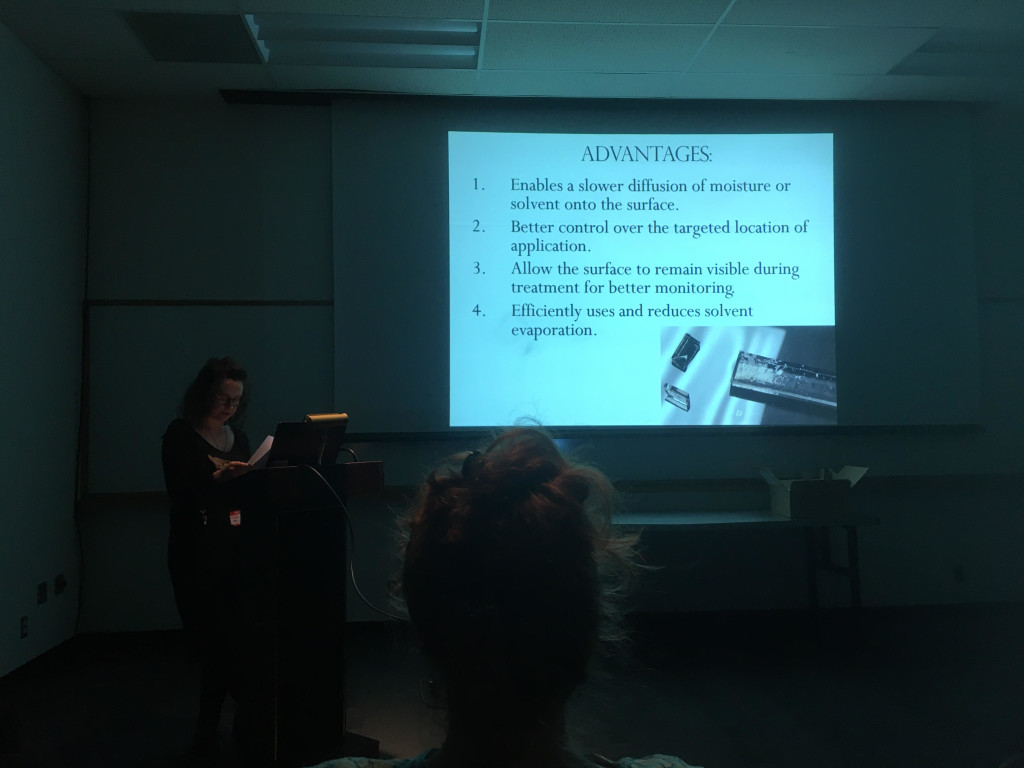Presenter: Nora Bloch
Write up: J. Riley Cruttenden; pre-program conservation intern, National Museum of the American Indian
Nora Bloch contributed to the 2018 3-Ring Circus held at the S. Dillon Ripley Center by presenting initial case studies on the effectiveness of rigid gels to reduce the appearance of tidelines on leather.

Bloch, a Kress Conservation Fellow at the University of Virginia Library, has previously used low-acyl gellan gum to successfully remove a cloth lining from a paper map and recently began investigating the usefulness of rigid gels in aesthetic leather treatments. She shared the advantages of gellan gum and agar in conservation treatments, discussed gel preparation methods, and shared preliminary findings of testing currently underway to reduce the visual impact of tidelines using gellan gum and agar. Advantages of gels include good, targeted control of solvent application, an efficient use of solvents, and good visibility for treatment monitoring (particularly for clear gels). Gels also allow for a slower diffusion of moisture and/or solvent onto the surface of the object being treated, an advantage with potentially high value for treating leather and other materials that are particularly sensitive to moisture.
Bloch is using a copy of Thomas Jefferson’s Notes on the State of Virginia from the University of Virginia Library’s Albert and Shirley Small Special Collections Library as a case study. The book has an original leather cover with tidelines on the upper portion of its front and back, from an earlier conservation intervention. Bloch has been exploring low-acyl gellan gum, high-acyl gellan gum, and agar gel prepared from combinations of water and isopropanol to reduce tidelines on the book’s cover. Bloch prepared low-acyl gellan gum from a 4% solution of gellan gum in water. The solution was heated over small intervals in a microwave until it achieved a temperature over 90 degrees Celsius. The hot solution was poured into silicon baking molds to a depth of 4 mm then allowed to cool. The resultant gel sheets were cut into slivers measuring 1 x 2 mm, then soaked in isopropanol until the slivers became opaque. The low-acyl gellan gum slivers were then placed along tidelines on the case study book for exposure times of roughly 45 seconds. Slivers were spaced several millimeters apart from each other along one of the tidelines, and several hours were allowed to pass between applications. The low-acyl gellan gum seemed to release solvent unevenly, and it was difficult to control the location of solvent applications using the gel slivers. Overall, this method did not offer a significant visual improvement on the object. High acyl gellan gum may prove to be more effective. Bloch has had difficulty achieving ideal high acyl gellan gum gels so far, but will continue to explore additional preparation methods with the addition of calcium acetate.
Bloch also tested agar gel prepared by the following method: 4 grams of agar and 50 mL of water were heated in a bain marie until the solution reached roughly 85 degrees Celsius and the liquid became transparent. At this stage the solution was removed from the heat and 50 mL of isopropanol were combined. The solution was poured into a silicon baking mold to a depth of 4 mm and allowed to cool. The gel sheets were cut into 1 x 2 mm slivers and applied in the same manner as the low-acyl gellan gum slivers described above. The agar gel slivers proved much easier to work with: they retained isopropanol longer and released the solvent more evenly. The agar gel successfully softened a tideline, and was more effective than the comparable tests with low-acyl gellan.
Although the tests are still in an early stage, Bloch offered exciting observations on the successes and difficulties she’s encountered using gels for reducing tidelines on leather. So far, agar gel treatments have proved to be the most successful, but Bloch plans to continue to explore high acyl gels and other gel variations as she continues her fellowship with University of Virginia Library.